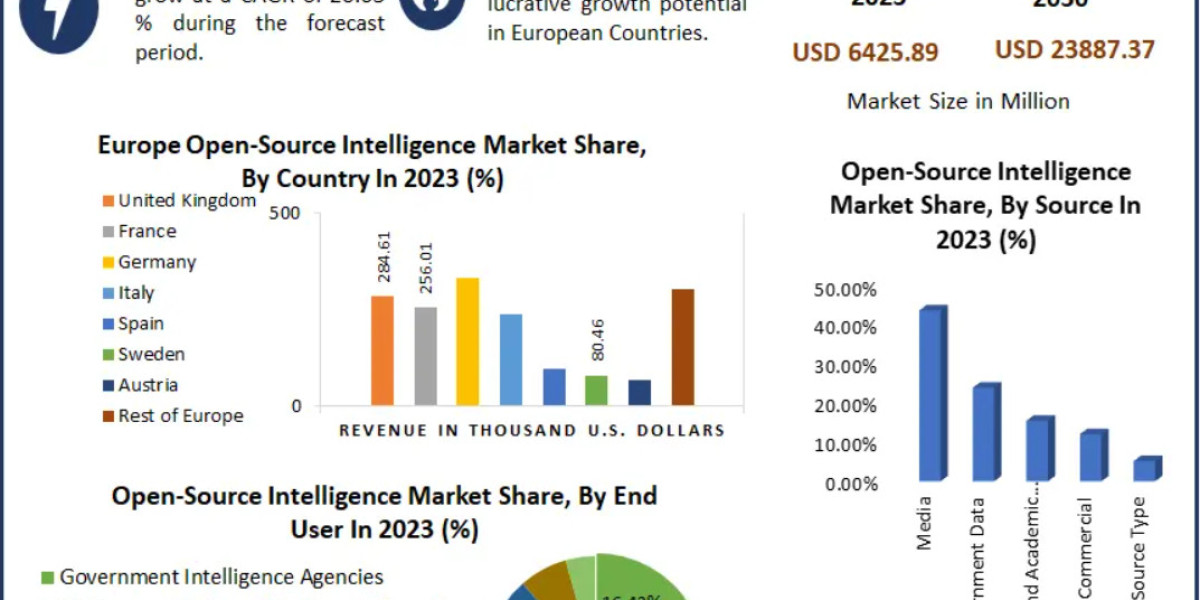Open-Source Intelligence Market: Transforming Data into Actionable Insights
The Open-Source Intelligence (OSINT) Market, valued at USD 6,425.89 million in 2023, is projected to grow at a remarkable CAGR of 20.63% from 2024 to 2030, reaching nearly USD 23,887.37 million. The market’s expansion is being fueled by the increasing reliance on publicly available information, rapid technological advancements, and growing demand for actionable intelligence across defense, government, and commercial sectors.
To know about the Research Methodology :- Request Free Sample Report@https://www.maximizemarketresearch.com/request-sample/66653/
Understanding Open-Source Intelligence
OSINT involves collecting and analyzing publicly accessible data to support informed decision-making. Contrary to popular belief, OSINT extends beyond simple internet searches and can include proprietary or subscription-based sources such as news journals, academic publications, and specialized databases. Its primary objective is to transform vast volumes of raw information into structured, actionable insights, enabling faster, more precise decision-making.
OSINT has evolved with technology, replacing traditional, time-consuming methods of intelligence gathering. Modern OSINT tools efficiently handle large datasets, providing insights that are critical for national security, corporate risk management, and cybersecurity operations.
Market Drivers
1. Rising Demand for Defense Applications:
National security priorities are driving governments worldwide to adopt OSINT technologies for intelligence gathering. OSINT supports military reconnaissance, strategic planning, and threat mitigation by combining open-source data with classified information. The integration of AI and big data enhances tactical intelligence, enabling more effective allocation of military resources.
2. Government Initiatives for Data Protection:
Governments globally are implementing stringent data protection policies, including the EU GDPR and Australia’s Privacy Principles. These regulations emphasize the need for secure intelligence-gathering methods, encouraging the adoption of OSINT tools by defense, law enforcement, and cybersecurity agencies.
3. Adoption of Artificial Intelligence and Big Data Analytics:
The use of AI and advanced analytics in OSINT is increasing operational efficiency, automating data collection, and improving predictive threat detection. Security analytics, in particular, dominated the OSINT market in 2023, reflecting its critical role in identifying and mitigating cyber threats.
4. Growth of Social Media Intelligence (SOCMINT):
SOCMINT tools enable real-time monitoring of social media platforms to detect emerging threats, track sentiment, and support situational awareness. Tools like SL Crimewall, NexVision Social, and Boardreader are transforming how organizations monitor and analyze social activity for actionable intelligence.
To know about the Research Methodology :- Request Free Sample Report@https://www.maximizemarketresearch.com/request-sample/66653/
Challenges and Restraints
Despite its growth, the OSINT market faces several challenges:
Data Quality Concerns: High volumes of unverified data can reduce accuracy and reliability.
Cybersecurity Vulnerabilities: Open-source systems are prone to attacks, particularly as AI integration increases.
Privacy and Ethical Issues: AI-driven monitoring raises regulatory and ethical concerns about user privacy.
Technical Limitations of Open-Source Software: Lack of dedicated support and delayed security patches can pose risks for organizations relying on OSINT.
Market Segmentation
By Technique:
Security Analytics: Dominant segment with widespread adoption in cybersecurity and defense.
Text Analytics: Fast-growing segment for processing large textual datasets.
Social Media Analytics: Used for monitoring trends, public sentiment, and threats.
Video and Geospatial Analytics: Applied in surveillance, threat detection, and spatial intelligence.
By Source Type:
Media, government data, professional and academic publications, commercial sources, and others.
By End User:
Government intelligence agencies, military and defense agencies, law enforcement, cybersecurity organizations, financial services, and specialized private businesses.
To know about the Research Methodology :- Request Free Sample Report@https://www.maximizemarketresearch.com/request-sample/66653/
Regional Insights
North America:
Dominates the global OSINT market, led by the United States and Canada. The adoption of OSINT by government, defense, and law enforcement agencies, combined with increased cybersecurity budgets, drives regional growth.
Europe:
Countries like the UK, Germany, and France focus on regulatory compliance and AI integration, enhancing OSINT adoption.
Asia-Pacific:
Rapid digitalization in China, India, South Korea, and Japan, coupled with rising cyber threats, is boosting the region’s market growth.
Middle East & Africa:
Investment in defense and cybersecurity infrastructure is accelerating OSINT adoption, with hubs such as the UAE leading in regional expansion.
South America:
Growth is driven by emerging cybersecurity needs and increasing awareness of threat intelligence solutions.
Competitive Landscape
Key players driving the OSINT market include:
North America: Babel Street, Cobwebs Technologies, Flashpoint Inc., IBM, Palantir, Recorded Future, ZeroFox.
Europe & MEA: Neotas, CybelAngel, Thales Group, Maltego, Hensoldt Analytics GmbH, Check Point Software Technologies.
Asia-Pacific: Fivecast, OSINT Combine, Forward Defens.
These companies are leveraging AI, analytics, and cloud-based OSINT solutions to enhance intelligence gathering, improve operational efficiency, and expand global presence. Strategic partnerships and technological innovations remain central to maintaining competitiveness in this fast-evolving market.
Conclusion
The Open-Source Intelligence market is transforming how governments, defense organizations, and private enterprises gather and utilize information. Driven by AI, big data, SOCMINT tools, and regulatory compliance requirements, OSINT is poised for rapid growth in the coming decade. While challenges related to cybersecurity, privacy, and data quality exist, robust technological solutions and strategic investments are enabling organizations to maximize the value of open-source intelligence for decision-making, national security, and corporate risk management.








